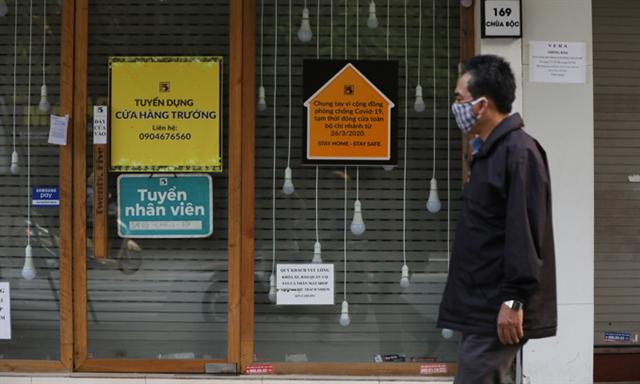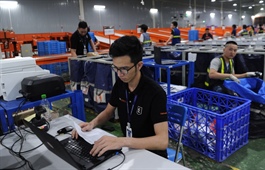2020 and Covid-19: Vietnamese economy down but not out
2020 and Covid-19: Vietnamese economy down but not out
Covid-19 crippled key sectors and the economy plunged in 2020, but Vietnam expects to make a strong recovery after managing the pandemic effectively.
A man walks past a closed shop in Hanoi on April 13, 2020 amid a nation-wide social distancing campaign to curb the spread of the novel coronavirus. Photo by VnExpress/Ngoc Thanh.
|
"2020 has been a particularly difficult year for Vietnam with most sectors, especially services and manufacturing, suffering Covid-19 impacts. This has resulted in dwindling GDP growth," said economist Le Dang Doanh.
The country began the year with a 6.8 percent GDP growth target after growing by more than 7 percent the previous two years, but the Covid-19 pandemic pushed most targets beyond reach.
Growth in the first nine months hit 2.1 percent, lowest in a decade, as trade activities stalled and the manufacturing sector suffered dwindling demand.
With hundreds of new cases recorded in two outbreaks in March and August, several experts forecast a GDP contraction for the first time in decades.
Tourism, which had enjoyed double-digit growth in recent years, was among the hardest hit. Highly popular beaches in the central region became deserted in April and August as social distancing measures were imposed to curb the spread of the novel coronavirus.
Foreign arrivals in the first 11 months plunged nearly 77 percent year-on-year to 3.8 million people, against the annual target of welcoming 20.5 million for the year.
Tourism revenues in the period fell nearly 59 percent year-on-year to VND16.6 trillion ($722 million),with the sharpest drops recorded in the central provinces of Khanh Hoa and Quang Nam, home to the tourist hotspots of Nha Trang and Hoi An.
The aviation industry was another major victim of the pandemic. The number of flights operated by five domestic airlines dropped 36 percent year-on-year in the first 11 months to 196,600, according to the Civil Aviation Authority of Vietnam (CAAV).
The state-owned Vietnam Airlines said the pandemic has nearly emptied its cash reserves. It expects a VND15.2 trillion ($654 million) loss for the whole year, while budget carrier Vietjet posted a loss of nearly VND925 billion in the first nine months.
All five domestic airlines have requested government support for overcoming perhaps the most challenging years in the history of the industry. Experts estimate that it would take at least until 2022 for the industry to recover to pre-pandemic levels.
Most manufacturing sectors suffered, with textile and garment one of the worst hit as producers struggled to source materials from China in February and March after protective measures were imposed to prevent the spread of the novel coronavirus.
Although imports resumed in April, producers faced difficulties again as outbreaks in the U.S. and the E.U. caused demand to plunge and buyers started canceling or delaying orders.
Although most Vietnamese companies tried to switch their production chain to masks and other pandemic-related products, the industry could still see its export value falling for the first time in 25 years, the Ministry of Industry and Trade has forecast.
Businesses closed and employees lost their jobs or part of their income. Nearly 93,500 companies suspended businesses in the first 11 months, up nearly 16 percent year-on-year.
An estimated 31.8 million workers were affected by the pandemic in the first nine months, with 14 percent laid off and the rest seeing their work hours and income cut, according to the General Statistics Office.
Over 983,000 people filed for unemployment benefits in the first 10 months, up 32.5 percent year-on-year, and the figure is set to hit 1.2 million for the whole year.
"The longer the pandemic, the more severe the impact. Vietnam’s GDP growth target of 6.8 percent for the year will be very difficult to meet,"Minister of Planning and Investment Nguyen Chi Dung predicted in April.
The country has lowered its target to 2.5-3 percent this year.
Speedy recovery
However, Vietnam is considered a bright spot on the world map thanks to its early and effective containment of the pandemic.
Economist Doanh said Vietnam’s drastic efforts to ensure growth this year creates a firm foundation for a strong recovery in 2021, when the severity of the Covid-19 situation reduces thanks to vaccines and global trade resumes.
Most international organizations back Doanh. The World Bank forecasts that Vietnam’s GDP growth will reach 2.8 percent this year, among the highest in the world, while the global economy is set to contract by 4.4 percent.
Vietnam will be one of only three countries in Asia to record positive growth this year, the other two being China and Myanmar, the bank said.
Lender HSBC and market research company Fitch Solutions have forecast Vietnam’s GDP growth to hit over 8 percent next year, while the Asian Development Bank (ADB) and the International Monetary Fund (IMF) have pegged it at 6-6.5 percent, respectively.
A bright silver lining this year has been a record high trade surplus of $20.1 billion in the first 11 months, with some export sectors able to maintain double-digit growth such as electronics and computers (up 24.3 percent year-on-year), machinery and equipment (up 44.5 percent) and wood (up 14.1 percent).
Doanh said that exports are expected to increase strongly next year thanks to the EU-Vietnam Free Trade Agreement (EVFTA) that took effect in August.
Other successes in negotiating and signing trade pacts like the Regional Comprehensive Economic Partnership (RCEP) and the Vietnam – U.K. Free Trade Agreement (UKVFTA) will help diversify Vietnam’s export markets and let domestic companies reach more buyers in upcoming years, he said.
























